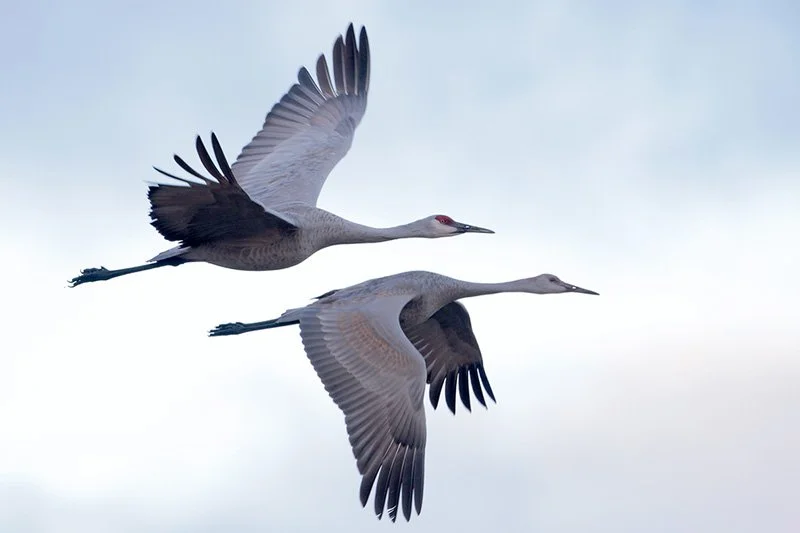Sandhill Cranes (Antigone canadensis)
by Christine Naspinski
Sandhill Cranes Flying, Photo Courtesy of Greg Lavaty
On a blustery day in late November, I visited Indiangrass Preserve for the first time. I had the Ann Hamilton Trail to myself, enjoying the songbirds calling and briefly popping up above the grass. Gradually I became aware of a trilling, bugle-like sound gradually growing louder, and I looked up to see a flock of Sandhill Cranes wheeling in the sky. I felt that the cranes were welcoming me to their winter home.
Sandhill Cranes (Antigone canadensis) fly with necks outstretched and legs trailing behind, their broad wings six feet across with “fingers” at the tips. On land, they stand 3 to 4 feet tall, with a heavy body, long legs and a long neck. Adults are mostly gray with dark legs and bill, a red crown and white cheeks. Immature birds have a mixture of gray and rusty plumage. Of similar-sized birds, the Great Blue Heron is probably the most likely to be mistaken for a crane; however, it is slimmer overall, has a longer neck, larger head, yellow bill, and usually flies with its neck folded back.
Sandhill Cranes, Courtesy of Don Pine
Sandhill Cranes are widely distributed throughout North America but form several distinct populations. The birds we see around the Texas Gulf Coast are part of the Mid-Continent. Population which breeds in northcentral U.S. and central Canada. In late summer they form huge flocks that then head south, funneling through the Dakotas, Nebraska, and Kansas. Audubon’s online Field Guide calls this gathering of migrating cranes “among the greatest wildlife spectacles on the continent.”
During migration and winter, Sandhill Cranes spend the night roosting in shallow water, resting with their head tucked under a wing. In the morning, the flock takes off to spend the day on feeding grounds. In this video from Crane Trust, you can hear the cacophony as cranes wake up on the Platte River, a major migration staging area. They prefer open areas such as grasslands, agricultural fields, marshes and coastal wetlands, where they forage for seeds, tubers, cultivated grains, insects and other invertebrates, and small mammals, reptiles and amphibians.
Sandhill Cranes, Photo courtesy of Tommy Kibodeaux
The peak time to see Sandhill Cranes on the Texas Gulf Coast is November through February. Hotspots for viewing sandhills include Brazos Bend State Park and Anahuac National Wildlife Refuge. In mid-December, Galveston Island hosts its Holiday with the Cranes celebration with field trips and presentations. If you are inspired to take a winter road trip, head to Muleshoe National Wildlife Refuge in the Panhandle to see large flocks. And, of course, check regularly at the Coastal Prairie Conservancy’s Indiangrass Preserve (eBird hotspot page) and Warren Lake at the Shrike Prairie (eBird hotspot page).
Though once threatened, migratory populations of Sandhill Cranes have made a comeback, helped along by conservation measures for their endangered cousin, the Whooping Crane. Sandhills are vulnerable to habitat degradation, especially at major migration stopover points. Because flocks can eat large quantities of cultivated grains, one important issue is how to safely deter them from agricultural fields. Though their current conservation status is Low Concern, the Survival by Degrees project considers them At Risk due to climate change.
To find out how you can help Sandhill Cranes and other at-risk birds, go to the project’s website.
Want to learn more about Sandhill Cranes? Check out these additional resources:



